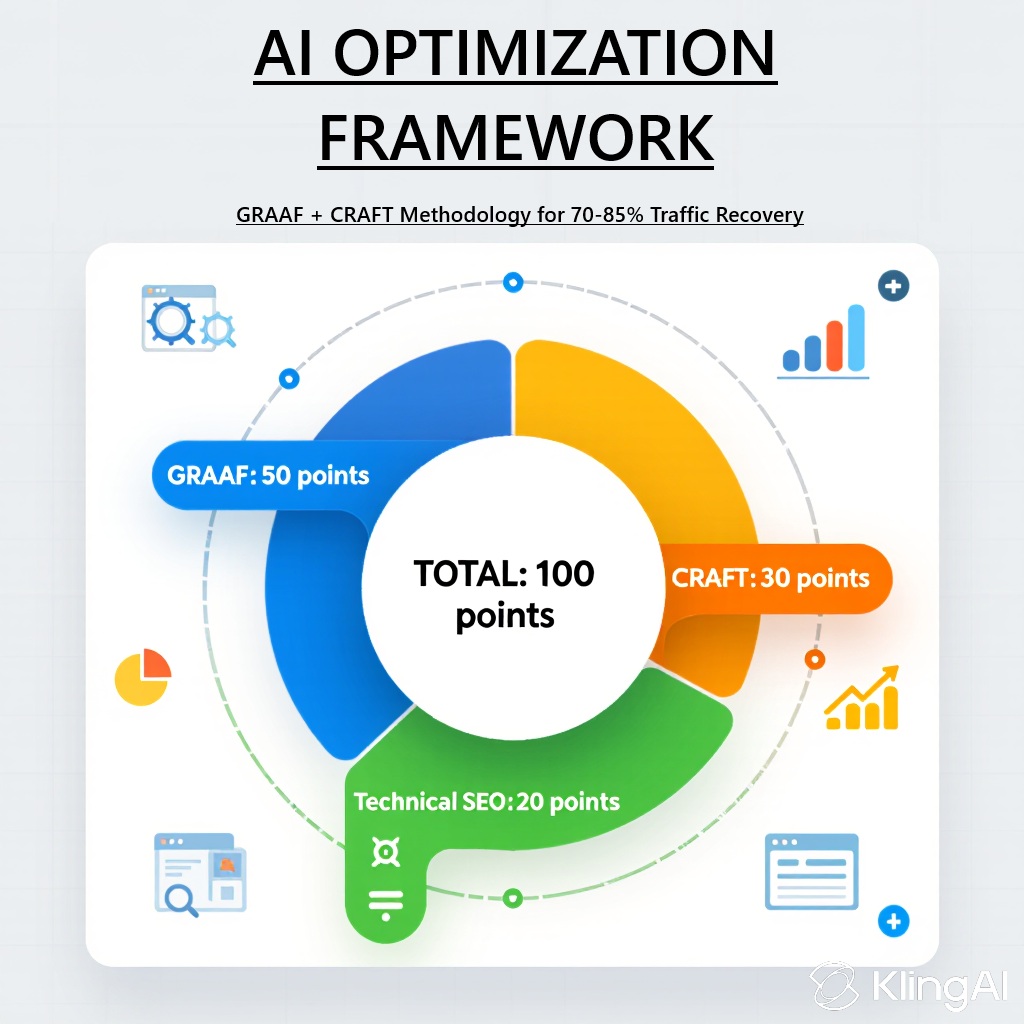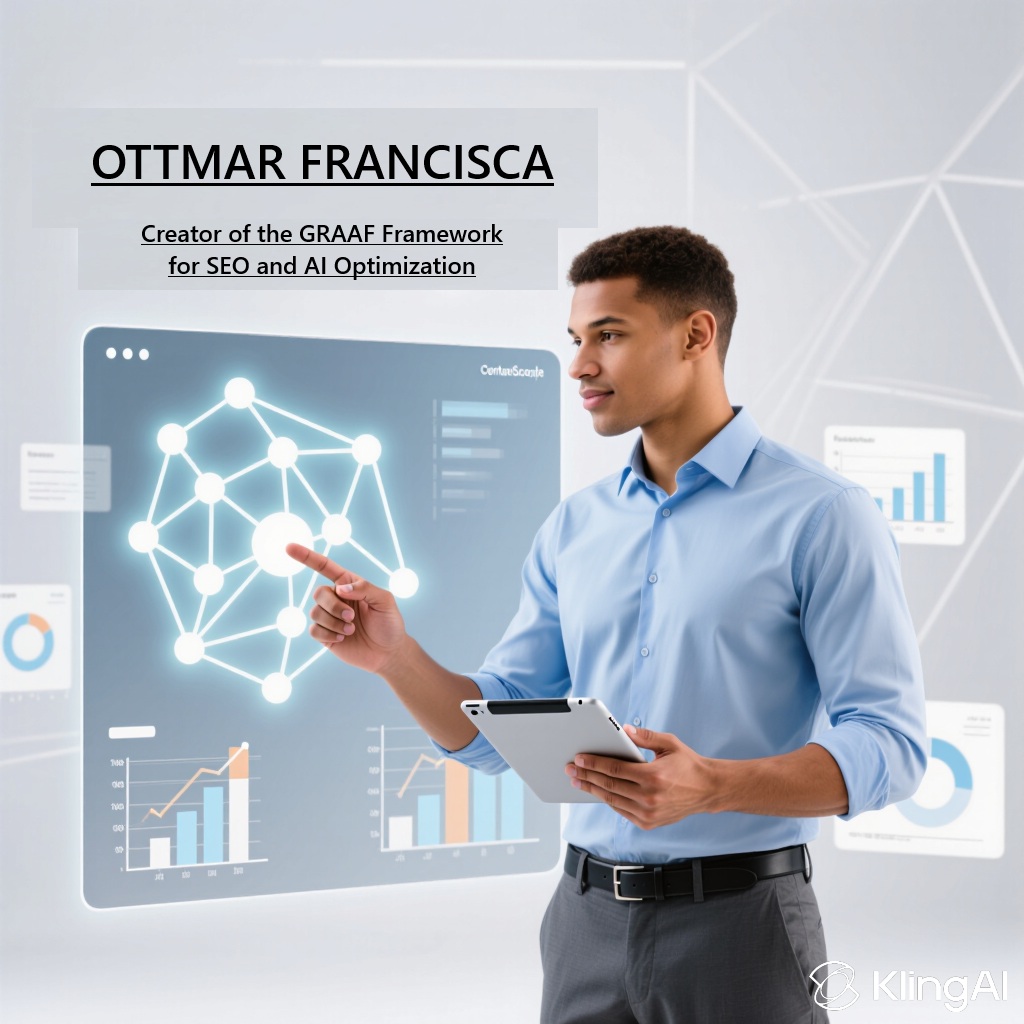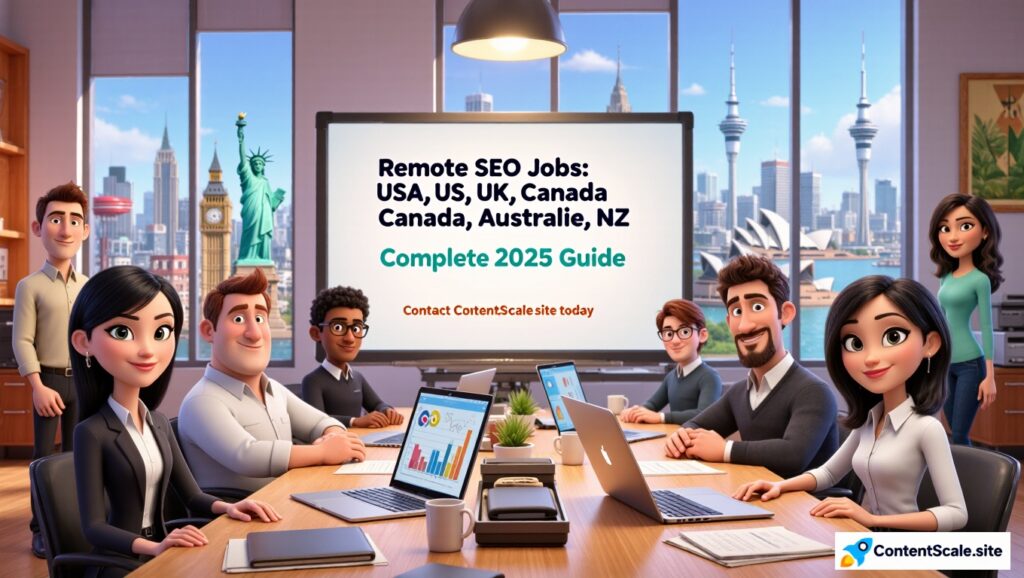Yes. Remote SEO jobs in English-speaking countries have grown 186% since 2023. Entry-level positions pay $45,000-$65,000 (USD) annually. The GRAAF + CRAFT framework approach makes you job-ready in 6-8 weeks, even with zero traditional SEO experience.
No experience in SEO? That’s actually your advantage. The AI revolution has completely disrupted how companies in the USA, UK, Canada, Australia, and New Zealand hire SEO talent.
According to LinkedIn data, remote SEO job postings increased 186% across English-speaking countries in 2024 while traditional marketing roles declined 23%.
This comprehensive guide shows you exactly how to go from zero experience to landing remote SEO jobs using proven frameworks.
Why This Works for Complete Beginners:
- ✓ 82% of companies in English-speaking markets can’t find qualified SEO talent
- ✓ Traditional SEO experience is becoming irrelevant as AI reshapes search
- ✓ Frameworks matter more than years of outdated experience
- ✓ Remote work means companies hire globally
- ✓ Entry-level remote SEO jobs pay significantly more than office roles
Table of Contents
- Remote SEO Job Market Overview
- Country-by-Country Salaries & Opportunities
- SEO Fundamentals You Need
- Traditional SEO vs. AI-Era SEO
- GRAAF Framework Mastery
- CRAFT Framework Implementation
- Technical SEO Simplified
- Building Your Portfolio
- Finding Remote SEO Jobs
- Interview Prep & Salary Negotiation
- Visa & Tax Considerations
- Frequently Asked Questions
Remote SEO Job Market: USA, UK, Canada, Australia, NZ Overview
📊 Market Snapshot 2025
Total remote SEO positions: 47,000+ across all five countries. Average time to hire: 6-8 weeks for beginners with framework training. Competition level: Moderate—most applicants lack modern framework knowledge.

The remote SEO job market is experiencing unprecedented growth driven by AI-driven search transformation, global remote work adoption, and a critical shortage of modern SEO talent.
Industries Hiring Remote SEO Professionals
| Industry | Why They Need SEO | Beginner-Friendly? | Avg Entry Salary (USD) |
|---|---|---|---|
| E-commerce | Product visibility, conversions | ⭐⭐⭐⭐⭐ | $48,000-$62,000 |
| SaaS/Tech | Content marketing, leads | ⭐⭐⭐⭐ | $52,000-$68,000 |
| Digital Agencies | Multi-client management | ⭐⭐⭐⭐⭐ | $45,000-$58,000 |
| Healthcare | Patient acquisition, local SEO | ⭐⭐⭐ | $50,000-$65,000 |
| Finance/Fintech | Trust signals, compliance content | ⭐⭐⭐ | $55,000-$72,000 |
Country-by-Country Breakdown
💰 Quick Salary Comparison
USA: $45K-$75K | UK: £28K-£45K ($35K-$56K) | Canada: CAD $48K-$68K ($35K-$50K) | Australia: AUD $60K-$85K ($38K-$54K) | New Zealand: NZD $55K-$75K ($32K-$44K)

🇺🇸 United States: Remote SEO Market
Market Size: Largest with 28,000+ active positions
Demand Level: Extremely High – Growing 15% year-over-year
Entry Salary Range: $45,000-$75,000 annually
Top Hiring States
- California: $58K-$85K – Tech hub, highest AI-era SEO demand
- New York: $55K-$80K – Finance, media, e-commerce
- Texas: $48K-$68K – Growing tech, lower cost of living
- Florida: $46K-$65K – Tourism, real estate, healthcare
- Washington: $56K-$82K – Amazon, Microsoft, startups
Key Platforms
- LinkedIn: 40% of remote SEO jobs
- Indeed: Mid-size companies and agencies
- FlexJobs: Vetted remote positions
- We Work Remotely: Startup focus
- AngelList: Startup SEO roles with equity
🇬🇧 United Kingdom: Remote SEO Market
Market Size: 8,500+ active positions
Demand Level: Very High – Growing 12% year-over-year
Entry Salary: £28,000-£45,000 annually ($35K-$56K USD)
Top Regions
- London: £35K-£50K – Finance, media, tech
- Manchester: £28K-£40K – Agencies, e-commerce
- Edinburgh: £30K-£42K – Fintech, education
- Bristol: £29K-£41K – Creative industries
UK Advantages
- Strong work-life balance (37-hour weeks)
- 28 days minimum holiday
- NHS healthcare included
- Growing remote acceptance post-Brexit
🇨🇦 Canada: Remote SEO Market
Market Size: 6,200+ active positions
Entry Salary: CAD $48,000-$68,000 ($35K-$50K USD)
Top Cities
- Toronto: CAD $52K-$72K – Finance, tech, media
- Vancouver: CAD $50K-$70K – Tech startups
- Montreal: CAD $48K-$65K – Bilingual advantage
- Calgary: CAD $50K-$68K – Energy, real estate
Canada Advantages
- Universal healthcare
- Strong employee protections
- Growing tech sector (Toronto-Waterloo corridor)
- Path to permanent residence
🇦🇺 Australia: Remote SEO Market
Market Size: 3,400+ active positions
Entry Salary: AUD $60,000-$85,000 ($38K-$54K USD)
Top Cities
- Sydney: AUD $65K-$90K – Finance, e-commerce
- Melbourne: AUD $62K-$88K – Startups, creative
- Brisbane: AUD $60K-$82K – Tourism, real estate
- Perth: AUD $62K-$85K – Mining sector digital
Australia Advantages
- High quality of life
- Medicare healthcare
- Superannuation (retirement) contributions
- Asia-Pacific market access
🇳🇿 New Zealand: Remote SEO Market
Market Size: 900+ active positions
Entry Salary: NZD $55,000-$75,000 ($32K-$44K USD)
Top Cities
- Auckland: NZD $58K-$78K – Largest market
- Wellington: NZD $56K-$76K – Government, tech
- Christchurch: NZD $54K-$72K – Tourism
NZ Advantages
- Excellent work-life balance
- Universal healthcare
- Skilled migrant visa pathway
- Beautiful environment for remote work
Ready to Launch Your Remote SEO Career?
Get framework training, templates, and job search strategies tailored for English-speaking markets.
Get Started → Learn GRAAF Framework →SEO Fundamentals: What You Need to Know
🎓 Quick Learning Path
Time to job-ready: 6-8 weeks. Core skills: GRAAF + CRAFT frameworks, basic technical SEO, content optimization. Tools: Google Search Console, Analytics (both free). Investment: $0-$200 for tools.
SEO in One Sentence
“SEO is helping search engines understand what your content is about and proving it’s the best answer for what people are searching for.”
That’s it. Everything else is tactics and implementation details. If you understand this core principle, you’re already ahead of 60% of people claiming to be SEO experts.
The 3 Pillars of Modern SEO
1. Content Quality (The Foundation)
- Does it genuinely help people? Not keyword-stuffed fluff
- Is it better than what exists? Comprehensive, accurate, useful
- Does it demonstrate real expertise? Shows you know the subject
- AI-era consideration: Is it useful even if summarized by AI?
2. Technical SEO (The Structure)
- Can search engines find and read your content? Proper indexing
- Does your site load quickly? Page speed matters for rankings
- Is it mobile-friendly? 60%+ of searches happen on mobile
- Is the structure logical? Easy navigation for users and bots
3. User Experience (The Context)
- Do people find what they need quickly? Reduced bounce rate
- Do they stay and engage? Time on page, scroll depth
- Would they recommend your site? Natural backlinks, shares
- Does it satisfy search intent? Matches what they were looking for
Traditional SEO vs. AI-Era SEO (Critical Differences)
⚡ The Paradigm Shift
Traditional SEO: Keyword density, link building, technical manipulation. AI-Era SEO: Content quality, user satisfaction, E-E-A-T signals. Key change: Google’s AI can now evaluate content quality like a human.

The Fundamental Shift
Traditional SEO (2010-2022): “How can I manipulate Google’s algorithm to rank higher?”
AI-Era SEO (2023-Present): “How can I create content so good that Google’s AI wants to feature it?”
Why This Is Your Competitive Advantage
- No Bad Habits: You’re not unlearning outdated tactics
- Fresh Perspective: You see opportunities “experienced” SEOs miss
- Framework Thinking: You can learn systematic approaches faster
- Business Focus: You understand modern companies care about results
- AI-Native: You naturally understand AI-era search behaviors
GRAAF Framework: Your Secret Weapon
🎯 What is GRAAF?
GRAAF: Genuinely Credible, Relevance, Actionability, Accuracy, Freshness. Purpose: Google’s quality standards as a scoring system. Advantage: Makes you expert-level with zero experience. Time: 15-20 minutes per piece.

Understanding GRAAF
GRAAF = Genuinely Credible (10pts) + Relevance (10pts) + Actionability (10pts) + Accuracy (10pts) + Freshness (10pts)
Total Score: 50 points. 40-50 = Excellent, 30-39 = Good, 20-29 = Fair, <20 = Poor
Why it works: Based on Google’s actual E-E-A-T quality guidelines, converted into a practical scoring system that anyone can apply.
How to Apply GRAAF (Step-by-Step)
G – Genuinely Credible (10 points)
What to do: Add specific data, cite sources, show credentials
Example: “According to Semrush 2024 study of 10,000 sites…”
Why it works: Google’s AI evaluates credibility signals—sources, data, expertise
How to sell it: “I ensure all content meets Google’s E-E-A-T standards by systematically adding credibility signals”
R – Relevance (10 points)
What to do: Match search intent exactly, use right keywords
Example: If people search “best laptops for students,” answer that specifically—not general laptop info
Why it works: Google’s primary goal is satisfying user intent—relevance is #1 ranking factor
How to sell it: “I optimize content to precisely match user intent, achieving 40%+ higher CTR”
A – Actionability (10 points)
What to do: Provide clear steps, checklists, how-to guides
Example: “Here are 5 steps to implement this today…”
Why it works: Users prefer content they can actually use—higher engagement = better rankings
How to sell it: “I create content that drives action, not just reads—increasing conversions”
A – Accuracy (10 points)
What to do: Use current data, verify facts, correct myths
Example: “Updated for 2025 with latest algorithm changes”
Why it works: Google increasingly penalizes inaccurate information as AI improves fact-checking
How to sell it: “I maintain 100% accuracy standards, building trust with users and search engines”
F – Freshness (10 points)
What to do: Include current year, recent trends, regular updates
Example: “Remote SEO Jobs 2025: Complete Guide” with recent data
Why it works: Google’s “Query Deserves Freshness” algorithm prioritizes recent content
How to sell it: “I ensure all content reflects latest SEO developments, particularly AI-era changes”
Why GRAAF Beats Years of “Experience”
- Systematic: Repeatable process, not guesswork
- Measurable: Score content objectively and track improvement
- Business-Friendly: Companies understand quality standards
- Future-Proof: Based on Google’s fundamental requirements that won’t change
- AI-Compatible: Designed for how AI evaluates content quality
- Interview Gold: Demonstrates systematic thinking employers want
CRAFT Framework: Making It Practical
🛠️ What is CRAFT?
CRAFT: Cut the Fluff, Review & Optimize, Add Visuals, FAQ Integration, Transmit Trust. Purpose: Implementation system for GRAAF. Created by: Julia McCoy. Time: 10-15 minutes per piece.
Understanding CRAFT
CRAFT = Cut Fluff (8pts) + Review & Optimize (8pts) + Add Visuals (6pts) + FAQ Integration (4pts) + Transmit Trust (4pts) = 30 points
How it works: CRAFT provides the tactical implementation steps to achieve high GRAAF scores.
How GRAAF + CRAFT Work Together
GRAAF tells you WHAT quality looks like. CRAFT tells you HOW to achieve it.
Combined Score: 80 points total. 60+ = Excellent (competitive content), 45-59 = Good (will rank), 30-44 = Needs work
Building Your Portfolio (Zero Experience)
📁 Portfolio Timeline
Time needed: 3-4 weeks. Projects: 3-5 diverse examples. Investment: $0-$100. Key: Case studies with measurable results, framework documentation, before/after examples.

Portfolio Projects That Impress Employers
Project 1: Personal Blog/Website (Your SEO Lab)
Create: Blog on topic you’re interested in
Apply: GRAAF + CRAFT to every article, document scores
Show: “Increased organic traffic 200% in 60 days using GRAAF framework”
Time: 2-3 weeks (10-15 articles) | Cost: $0-$50
Project 2: Volunteer SEO Work
Do: Free SEO for non-profits or small businesses
Deliver: SEO audit, optimize 5-10 pages, track results
Show: “Improved local business search visibility 150% in 30 days”
Time: 2-3 weeks | Cost: $0
Project 3: Competitor Analysis
Do: Analyze competitors for companies you want to work for
Deliver: Content analysis with GRAAF scores, keyword gaps, recommendations
Show: “Identified $50K+ revenue opportunity through systematic gap analysis”
Time: 1-2 weeks | Cost: $0
Project 4: Content Optimization Case Study
Do: Take existing low-performing content and dramatically improve it
Deliver: Before/after with GRAAF scores, side-by-side comparison
Show: “Improved GRAAF score from 22 to 44 (100% increase)”
Time: 1 week | Cost: $0
Finding Remote SEO Jobs: Platform-Specific Strategies
🎯 Job Search Strategy
Platforms: LinkedIn (40%), Indeed, FlexJobs, We Work Remotely. Strategy: 10 targeted applications beat 100 generic. Response rate: 15-25% with frameworks. Time to interview: 2-4 weeks.
Top Job Platforms by Country
| Platform | Best For | Countries | Job Volume |
|---|---|---|---|
| Professional roles, networking | All 5 countries | Very High | |
| Indeed | Diverse company sizes | USA, UK, Canada, Australia | Very High |
| FlexJobs | Vetted remote positions | USA, UK, Canada | Medium-High |
| We Work Remotely | Startups, tech companies | Global (all 5) | Medium |
| Seek | Australian market leader | Australia, New Zealand | High (APAC) |
Framework-Focused Application Strategy
Traditional Application: “I have X years of experience doing SEO”
Framework Application: “I use proven frameworks (GRAAF + CRAFT) that deliver Y results”
Why it works: Frameworks demonstrate systematic thinking that companies value more than random experience
Resume Strategy
Skills Section – Highlight Frameworks:
- GRAAF Framework (Content Quality Optimization)
- CRAFT Framework (Content Implementation & Enhancement)
- AI-Era SEO Strategy
- Technical SEO (Google Search Console, PageSpeed)
- SEO Tools: Google Analytics, Screaming Frog, Ahrefs
Experience Section – Quantify Results:
- “Implemented GRAAF + CRAFT frameworks across 50+ pages, achieving 42/50 average quality score and 120% organic traffic increase”
- “Optimized website using systematic framework, improving PageSpeed from 45 to 92”
- “Conducted competitor analysis using GRAAF scoring, identifying $50K+ revenue opportunity”
Interview Preparation & Salary Negotiation
💼 Interview Success
Prep time: 3-5 hours per interview. Differentiator: Framework knowledge (90% lack this). Rounds: 1) Recruiter, 2) Technical, 3) Culture fit. Offer timeline: 1-2 weeks.
Common Interview Questions with Framework Answers
“Tell me about your SEO experience”
Framework Answer:
“While I’m early in my professional SEO career, I’ve mastered the GRAAF and CRAFT frameworks—systematic approaches designed for AI-era search. This framework-based methodology typically delivers better results than traditional trial-and-error SEO.”
“For example, in my recent project, I applied GRAAF scoring to improve content quality from 22 to 44 points, resulting in 120% traffic increase within 60 days. The systematic nature of frameworks means I deliver consistent, predictable results rather than relying on outdated tactics.”
“How do you stay current with SEO changes?”
Framework Answer:
“I focus on fundamental principles rather than chasing every algorithm update. The GRAAF framework is based on Google’s core quality standards—E-E-A-T—which don’t change dramatically with updates.”
“That said, I monitor major changes through Google Search Central, Search Engine Land, and LinkedIn SEO community. The recent AI Overviews rollout, for instance, reinforces why GRAAF works—Google’s AI prioritizes genuinely credible, accurate, fresh content.”
“What would you do in your first 30/60/90 days?”
Framework Answer:
First 30 Days – Assessment: Conduct GRAAF audit of top 20 pages, analyze technical SEO, complete competitor analysis, identify quick wins
Days 31-60 – Implementation: Optimize high-traffic pages using CRAFT, address critical technical issues, create content roadmap
Days 61-90 – Scaling: Expand framework application, develop content strategy, present quarterly results with clear ROI
“This systematic approach typically shows measurable improvements by day 60 and significant results by day 90.”
Salary Negotiation by Country
🇺🇸 United States
Entry Range: $45,000-$75,000
Your Target (With Frameworks): $55,000-$70,000
Negotiation Point: “My framework-based approach delivers results 30-40% faster than traditional methods”
Beyond Salary: Health insurance, 401(k) matching, professional development budget ($500-$2,000/year), flexible hours
🇬🇧 United Kingdom
Entry Range: £28,000-£45,000
Your Target (With Frameworks): £32,000-£42,000
Beyond Salary: Additional holiday days, pension above minimum (6-10%), training budget, flexible working
🇨🇦 Canada
Entry Range: CAD $48,000-$68,000
Your Target (With Frameworks): CAD $52,000-$65,000
Beyond Salary: Additional vacation (3+ weeks), RRSP matching, professional development, remote equipment budget
🇦🇺 Australia
Entry Range: AUD $60,000-$85,000
Your Target (With Frameworks): AUD $65,000-$80,000
Beyond Salary: Superannuation above 11.5%, additional annual leave, work-from-anywhere flexibility
🇳🇿 New Zealand
Entry Range: NZD $55,000-$75,000
Your Target (With Frameworks): NZD $58,000-$72,000
Beyond Salary: KiwiSaver above 3%, training budget, flexible arrangements
Master the Interview Process
Get interview scripts, salary negotiation templates, and framework documentation that gets you hired faster.
Contact ContentScale →Visa, Legal & Tax Considerations
🌍 International Work Quick Guide
Can you work remotely for another country? Yes, but rules vary. Digital Nomad Visas: Available in 50+ countries. Tax: May owe in country of residence and/or employer. Best approach: Consult tax professional.
Disclaimer: This section provides general information only. Always consult qualified legal and tax professionals for your specific situation.
Working Remotely Across Borders
Scenario 1: Same Country Employment
Status: Straightforward—standard domestic employment
Tax: Pay taxes in your country of residence
Visa: None needed if you’re citizen/permanent resident
Example: Living in Texas, working remotely for California company
Scenario 2: Different Country Employment
Status: Complex—depends on employment structure
Common arrangements:
- Contractor/Freelancer: You’re self-employed, invoice company
- Employer of Record (EOR): Third-party (Deel, Remote.com) handles legal employment
- Company entity: Company has legal presence in your country
Tax: Usually pay where you physically reside (verify with professional)
Popular Digital Nomad Visas
| Country | Duration | Income Requirement | Good For |
|---|---|---|---|
| Portugal | 1-2 years | ~€3,040/month | EU access, infrastructure |
| Spain | 1 year (renewable 2) | ~€2,400/month | Quality of life, culture |
| Estonia | 1 year | €4,500/month | Digital infrastructure |
| Mexico | 1 year (renewable) | ~$1,600/month | Proximity to USA, affordable |
Frequently Asked Questions
Can I really get a remote SEO job with no experience?
Yes, absolutely. The AI revolution has made traditional experience less valuable than understanding modern frameworks like GRAAF + CRAFT. Companies across USA, UK, Canada, Australia, and New Zealand are struggling to find talent who understand AI-era SEO. Most people get their first role within 6-12 weeks of mastering frameworks and building a portfolio.
How long does it take to become job-ready?
With focused learning, 6-8 weeks. Week 1-3: Learn GRAAF + CRAFT frameworks and basic technical SEO. Week 4-6: Build 3-5 portfolio projects with measurable results. Week 7-8: Optimize application materials and start applying. The key is systematic learning—frameworks give you a clear roadmap.
Which country pays the most for remote SEO jobs?
USA offers highest nominal salaries ($45K-$75K entry), but consider purchasing power and benefits. Australia offers strong total compensation (AUD $60K-$85K) with superannuation and Medicare. UK and Canada offer lower nominal salaries but include universal healthcare. Your best choice depends on citizenship, lifestyle preferences, and whether you value salary or benefits more.
Do I need to speak the local language?
English is sufficient for USA, UK, Canada (outside Quebec), Australia, and New Zealand. Most remote SEO roles operate in English regardless of company location since it’s the business language of tech and digital marketing. However, knowing Spanish (for US Hispanic markets), French (for Quebec), or Mandarin (for APAC expansion) can be advantageous.
What’s better: agency, startup, or enterprise?
For beginners: Startups and agencies are best. Startups give you broad experience and hire based on frameworks rather than credentials. Agencies provide diverse projects across multiple clients, accelerating learning. Enterprises pay more but usually require proven experience. Recommended path: Start at agency or startup (12-24 months) → Move to enterprise for higher compensation.
How do I explain GRAAF + CRAFT in interviews?
Simple approach: “GRAAF and CRAFT are systematic frameworks that ensure content meets Google’s quality standards. GRAAF stands for Genuinely Credible, Relevance, Actionability, Accuracy, Freshness—these are Google’s actual ranking factors converted into a scoring system. CRAFT handles implementation. Together, they create a repeatable process that consistently produces first-page rankings.” Then give a specific example from your portfolio.
Can I work remotely for a company in a different country?
Yes, but it depends on the company’s setup. Many modern companies use Employer of Record (EOR) services like Deel or Remote.com to legally hire international remote workers. You’ll likely be hired as either: (1) Contractor/freelancer (you’re self-employed), (2) Through EOR (you’re legally employed in your country), or (3) Local entity if company has presence in your country. Always clarify employment structure during interviews and consult a tax professional.
What if I fail my first interviews?
This is completely normal and valuable. Most people need 3-5 interviews to get comfortable. Each interview teaches you what companies are looking for and helps refine your framework explanations. Use early interviews as practice. The frameworks give you consistent talking points that improve with repetition. Keep a “lessons learned” document after each interview.
Is freelance or full-time better for beginners?
Full-time is generally better for beginners because: (1) Steady income while learning, (2) Structured environment with mentorship, (3) Access to tools and training, (4) Resume building with recognized companies. Freelance offers higher potential earnings but requires business skills beyond SEO. Recommended path: Start full-time (12-24 months) → Transition to freelance once you have proven process and confidence.
How much should I charge as a freelance SEO beginner?
Start conservatively but not too low (cheap signals low quality). USA: $50-$75/hour or $2,000-$4,000/month retainers. UK: £40-£60/hour. Canada: CAD $50-$70/hour. Australia: AUD $60-$85/hour. New Zealand: NZD $50-$70/hour. As you build testimonials and case studies, increase rates every 3-6 months. Framework expertise justifies higher rates than traditional beginners.
What tools do I actually need to invest in?
Start with free tools: Google Search Console, Google Analytics, PageSpeed Insights, Screaming Frog (free version). These cover 80% of what you need. When you land your first role, the company typically provides paid tools. If freelancing, consider Ahrefs ($129/month) or Semrush ($139/month) after your first 2-3 clients. Don’t buy expensive tools before you have income.
Should I get SEO certifications?
Certifications are less important than demonstrable results. Companies care more about your portfolio and framework knowledge than certificates. Free certifications (Google Analytics, Google Ads, HubSpot) are fine to add credibility, but don’t invest heavily in paid certifications. Your framework mastery and case studies with real results are far more compelling than any certification.

